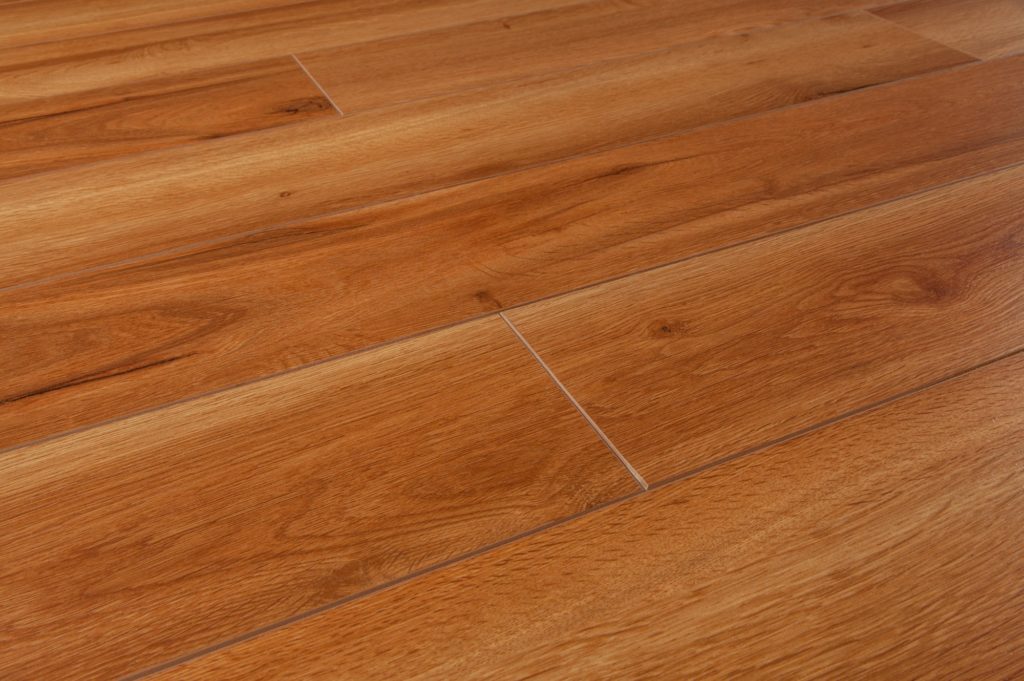LAMINATE FLOORING | An Architect Explains
Laminate flooring was created in the ’70s as an affordable alternative to solid hardwood or engineered wood flooring. It is a multi-layer synthetic flooring product with a printed top layer which simulates wood. Earlier, laminate floors looked fake or “plastic-y” but today, advanced printing technologies have enabled manufacturers to create laminates that look almost as real as the original. Versatile, easy to maintain, and reasonably priced, many people prefer laminate flooring to hardwood or engineered wood.

Laminate flooring is a multi-layer, synthetic flooring product fused together by a lamination process. The bottom layer is the “backing”. Above the backing is the inner core made from high-density fiberboard that is reinforced with a special resin. Next is the image design layer. This is where the high-resolution image of wood, stone, metal, or other material appears. And the top layer is the wear layer.
Laminate has both advantages and disadvantages. It is useful to know the characteristics of laminate, its usability and suitability as a flooring option. As an Architect, I have described Laminate along with it’s features under the following headings so that you can decide whether it is suited for your requirement and your space:
What are the advantages of Laminate flooring?
What are the disadvantages of Laminate flooring?
Where is Laminate flooring best suited?
WHAT ARE THE ADVANTAGES OF LAMINATED WOOD FLOOR?
- Convenient Packaging: Unlike solid hardwood which comes in 8 or 10 feet planks, laminate planks are sold in convenient 4 foot strips. They are also available in tile form in varying sizes.
- Versatility: Today laminate flooring can simulate the look of different natural hardwoods and even the surface texture of these natural materials. These printing processes can also reproduce the appearance of natural stones and ceramic flooring materials.
- Easy to clean: The protective, clear, wear layer of a laminate floor protects the material from stains making cleaning and maintenance easy.
- Installation: The installation of a laminate click-together floor is one of the easiest do-it-yourself flooring projects. You just roll down a sheet of under-laying material and then snap the planks or tiles of the floor into one another.
- Change existing floor: Laminate flooring can be installed over almost any existing floor in the home without the hassle and expense of having to remove the old flooring.
- Does not fade: Laminate flooring is resistant to many of the outdoor agents and UV light that can discolor and fade other flooring materials.
- Anti allergen: Unlike carpet, laminate flooring is allergen-free and naturally resistant to the growth of mold and bacteria.
- Allows for expansion: Laminate flooring is not adhered directly to the subfloor, rather all of the pieces of the floor are interlocked, or adhered one to another. That means that the material can expand, or contract, due to changes in pressure and temperature, without buckling and snapping against the subfloor.
- Acclimatisation: Hardwood needs to sit in an environment for 3-6 weeks so that it can acclimatise to the temperature and pressure of the area. Laminates can be installed in as little as 36 hours.

WHAT ARE THE DISADVANTAGES OF LAMINATED WOOD FLOOR?
- Refinishing: Laminate floors cannot be refinished as it has a single wear layer. Over time the wear layer will degrade and scratches will appear requiring the entire floor to be replaced.
- Sound: When you walk on a laminate floor it produces a hollow sound, quite unlike the sound of natural solid hardwood, that makes the material feel fake and manufactured.
- Unnatural Feel: While laminate can simulate the look of hardwood, stone, or brick perfectly, the illusion fades as soon as you feel the material with your bare hands.
- Hard: Laminate flooring is quite hard and unyielding under foot.
- Environmental Concerns: Some environmental experts have expressed concerns over laminate materials that are made with formaldehyde compounds as they are believed to release volatile organic chemicals that can have harmful effects on the room air quality.
- Lifespan: The life span of a laminate floor is going to be based on the quality of the material and the thickness of the wear layer. Off brands may have voids in core, which weakens the wood surface. The ends may split in cheaper brands.

WHERE IS LAMINATE FLOORING BEST SUITED?
Laminate flooring has grown significantly in popularity in homes, perhaps because it is easier to install and maintain than more traditional surfaces such as solid hardwood flooring. It costs less, is reasonably durable and hygienic. However it is made of a plastic (melamine resin) and is less durable than engineered wood flooring, with a lifespan of less than five years. In comparison linoleum lasts longer and costs much less.
For information on other flooring options, go to:
- Flooring | Natural Material Options
- Flooring | Man-made Material Options
- Flooring | Resilient Material Options
READ MORE:
In order to get a rough idea of the suitability of a particular flooring for your requirement and to make a fair comparison of the different types of flooring, refer to an Architect’s rating of the various kinds of flooring on my blog: House construction in India
If you found this post useful, all it takes is a simple click on the “pin it” “like,” “share,” “tweet,” or Google+ buttons below the post. Thank you!




